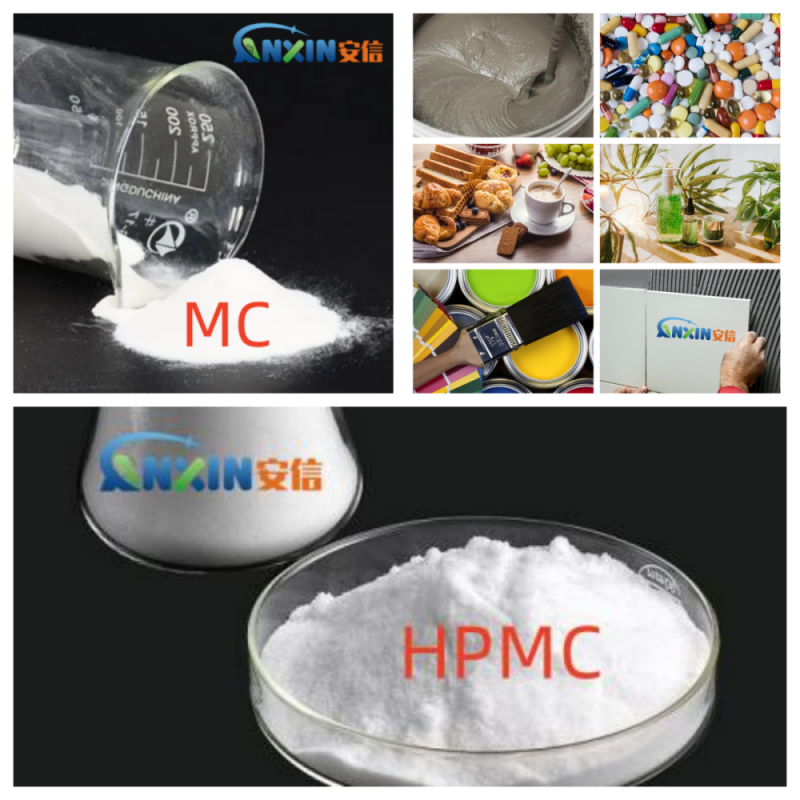Hydroxypropyl Methylcellulose (HPMC) and Methylcellulose (MC) are two common cellulose derivatives, which have some significant differences in chemical structure, properties and applications. Although their molecular structures are similar, both are obtained by different chemical modifications with cellulose as the basic skeleton, but their properties and uses are different.
1. Difference in chemical structure
Methylcellulose (MC): Methylcellulose is obtained by introducing methyl (-CH₃) groups into cellulose molecules. Its structure is to introduce methyl groups into the hydroxyl (-OH) groups of cellulose molecules, usually replacing one or more hydroxyl groups. This structure makes MC have certain water solubility and viscosity, but the specific manifestation of solubility and properties is affected by the degree of methylation.
Hydroxypropyl Methylcellulose (HPMC): HPMC is a further modified product of methylcellulose (MC). On the basis of MC, HPMC introduces hydroxypropyl (-CH₂CH(OH)CH₃) groups. The introduction of hydroxypropyl greatly improves its solubility in water and improves its thermal stability, transparency and other physical properties. HPMC has both methyl (-CH₃) and hydroxypropyl (-CH₂CH(OH)CH₃) groups in its chemical structure, so it is more water-soluble than pure MC and has higher thermal stability.
2. Solubility and hydration
Solubility of MC: Methylcellulose has a certain solubility in water, and the solubility depends on the degree of methylation. Generally, methylcellulose has low solubility, especially in cold water, and it is often necessary to heat the water to promote its dissolution. The dissolved MC has a higher viscosity, which is also an important feature in many industrial applications.
Solubility of HPMC: In contrast, HPMC has better water solubility due to the introduction of hydroxypropyl. It can dissolve quickly in cold water, and its dissolution rate is faster than MC. Due to the influence of hydroxypropyl, the solubility of HPMC is not only improved in cold water, but also its stability and transparency after dissolution are improved. Therefore, HPMC is more suitable for applications that require rapid dissolution.
3. Thermal stability
Thermal stability of MC: Methylcellulose has poor thermal stability. Its solubility and viscosity will change greatly at high temperature. When the temperature is high, the performance of MC is easily affected by thermal decomposition, so its application in high temperature environment is subject to certain restrictions.
Thermal stability of HPMC: Due to the introduction of hydroxypropyl, HPMC has better thermal stability than MC. HPMC’s performance is relatively stable at higher temperatures, so it can maintain good results in a wider temperature range. Its thermal stability enables it to be more widely used under some high temperature conditions (such as food and drug processing).
4. Viscosity characteristics
Viscosity of MC: Methyl cellulose has a higher viscosity in aqueous solution and is usually used in situations where high viscosity is required, such as thickeners, emulsifiers, etc. Its viscosity is closely related to concentration, temperature and the degree of methylation. A higher degree of methylation will increase the viscosity of the solution.
Viscosity of HPMC: The viscosity of HPMC is usually slightly lower than that of MC, but due to its higher water solubility and improved thermal stability, HPMC is more ideal than MC in many situations where better viscosity control is required. The viscosity of HPMC is affected by molecular weight, solution concentration and dissolution temperature.
5. Differences in application fields
Application of MC: Methyl cellulose is widely used in construction, coatings, food processing, medicine, cosmetics and other fields. Especially in the construction field, it is a common building material additive used for thickening, improving adhesion and improving construction performance. In the food industry, MC can be used as a thickener, emulsifier and stabilizer, and is commonly found in products such as jelly and ice cream.
Application of HPMC: HPMC is widely used in pharmaceuticals, food, construction, cosmetics and other industries due to its excellent solubility and thermal stability. In the pharmaceutical industry, HPMC is often used as an excipient for drugs, especially in oral preparations, as a film former, thickener, sustained-release agent, etc. In the food industry, HPMC is used as a thickener and emulsifier for low-calorie foods, and is widely used in salad dressings, frozen foods and other products.
6. Comparison of other properties
Transparency: HPMC solutions usually have high transparency, so they are more suitable for applications that require a transparent or translucent appearance. MC solutions are usually turbid.
Biodegradability and safety: Both have good biodegradability, can be naturally degraded by the environment under certain conditions, and are considered safe in many applications.
HPMC and MC are both substances obtained by cellulose modification and have similar basic structures, but they have significant differences in solubility, thermal stability, viscosity, transparency, and application areas. HPMC has better water solubility, thermal stability, and transparency, so it is more suitable for occasions that require rapid dissolution, thermal stability, and appearance. MC is widely used in occasions that require high viscosity and high stability due to its higher viscosity and good thickening effect.
Post time: Apr-06-2025


